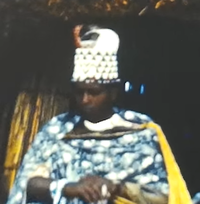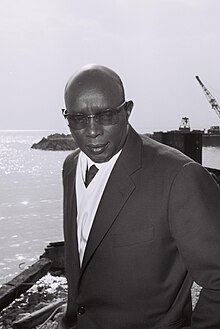List of kings of Burundi
| Mwami of Burundi | |
|---|---|
 | |
 | |
| Details | |
| Style | His Majesty |
| First monarch | Ntare III Rushatsi |
| Last monarch | Ntare V Ndizeye |
| Formation | c. 1680 |
| Abolition | 28 November 1966 |
| Residence | Gitega and Bujumbura, Burundi |
| Appointer | Hereditary |
| Pretender(s) | Princess Rosa Paula Iribagiza |
This article contains two versions of the list of kings of Burundi, the traditional version before 1680 and the modern genealogy. The Kingdom of Burundi was ruled by sovereigns, titled mwami (plural abami), whose regnal names followed a cycle: Ntare (meaning 'lion'), Mwezi (meaning 'moon'), Mutaga, and Mwambutsa. Traditionally, it was thought that there had been four complete cycles but the modern genealogy indicates that there were only two complete cycles, starting with Ntare III Rushatsi.
In the 16th century, Burundi was a kingdom characterized by a hierarchical political authority and tributary economic exchange. A mwami headed a princely aristocracy (ganwa) which owned most of the land governing its subjects with superiority and required a tribute, or tax, from local farmers and herders who lived in forests. The Tutsi monarchy ruled the nation for centuries, but became largely ceremonial with the colonization of the nation by the German Empire in 1899. The kings continued to nominally rule through German and Belgian colonial periods, and the monarchy continued after the nation gained independence from Belgium in 1962. Burundi ceased to be a monarchy when king Ntare V Ndizeye was deposed by his Prime Minister and Chief of Staff, Colonel Michel Micombero, who abolished the monarchy and declared a republic following the November 1966 coup d'état.[1][2]
Kings of Burundi[]
Traditional list[]
The dates before 1900 are estimates.
- Ntare I Rushatsi Cambarantama: c. 1530–c. 1550
- Mwezi I Baridamunka: c. 1550–c. 1580
- Mutaga I Mutabazi: c. 1580–c. 1600
- Mwambutsa I Nkomati: c. 1600–c. 1620
- Ntare II Kibogora: c. 1620–c. 1650
- Mwezi II Nyaburunga: c. 1650–c. 1680
- Mutaga II Senyamwiza Mutamo: c. 1680–c. 1700
- Mwambutsa II Nyarushamba: c. 1700–c. 1720
- Ntare III Kivimira Semuganzashamba: c. 1720–c. 1750
- Mwezi III Kavuyimbo (Ndagushimiye): c. 1750–c. 1780
- Mutaga III Sebitungwa: c. 1780–c. 1800
- Mwambutsa III Mbonyuburundi (Mbariza): c. 1800–c. 1830
- Ntare IV Runzi (Rutaganzwa Rugamba): c. 1830–c. 1850
- Mwezi IV Gisabo Bikata-Bijoga: c. 1850–1908
- Mutaga IV Mbikije: c. 1908–1915
- Mwambutsa IV Bangiricenge Rubangishamiheto: 1915–1966
- Ntare V Ndizeye: 1966
Modern list[]

- Ntare III Rushatsi: c. 1680–c. 1709
- Mwezi III Ndagushimiye: c. 1709–c. 1739
- Mutaga III Senyamwiza Mutamo: c. 1739–c. 1767
- Mwambutsa III Serushambo Butama: c. 1767–c. 1796 (also known as Mwambutsa III Mbariza)
- Ntare IV Rutaganzwa Rugamba: c. 1796–c. 1850
- Mwezi IV Gisabo: c. 1850 – 21 August 1908
- Mutaga IV Mbikije: 21 August 1908 – 30 November 1915
- Mwambutsa IV Bangiriceng: 16 December 1915 – 8 July 1966
- Ntare V Ndizeye: 8 July[3] – 28 November 1966[1]
See also[]
References[]
- ^ a b "BURUNDI PREMIER SETS UP REPUBLIC; Micombero Asserts He Has Overthrown the King". The New York Times. 1966-11-29. Retrieved 18 January 2021.
- ^ "MICHEL MICOMBERO, 43, DIES; FORMER PRESIDENT OF BURUNDI". The New York Times. 1983-07-18. Retrieved 24 April 2020.
- ^ "Power in Burundi Seized By Absent King's Son, 21". The New York Times. 1966-07-09. Retrieved 18 January 2021.
- History of Burundi
- Lists of African monarchs
- Burundian monarchy
- Burundian kings
- Burundi history-related lists
- Lists of Burundian people
